The Avenues is an affluent neighborhood in Salt Lake City, Utah. It is named after the perfectly gridlike, closely laid out roads called Avenues and Streets. First surveyed in the 1850s, the Avenues became Salt Lake City's first neighborhood. Today, the Avenues neighborhood is generally considered younger, more progressive, and somewhat "artsy" when compared to other neighborhoods. Many young professionals choose to live there due to the culture and easy commute to downtown.. It is also one of the most important strongholds of the Democratic political party in Utah.
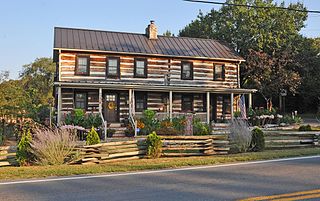
Darkesville is an unincorporated community in Berkeley County, West Virginia, United States. Established in 1791, Darkesville has been nationally recognized as a historic district.
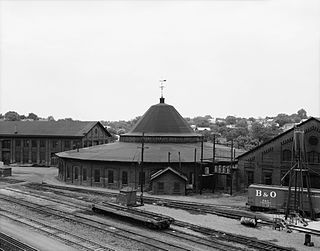
Baltimore and Ohio Railroad Martinsburg Shops is a historic industrial district in Martinsburg, West Virginia. It is significant both for its railroading architecture by Albert Fink and John Rudolph Niernsee and for its role in the Great Railroad Strike of 1877. It consists of three contributing buildings, one of which is the oldest covered roundhouse in the United States. The presence of the Baltimore and Ohio Railroad Company in Martinsburg dates back to the late 1840s, when the first engine and machine shops were erected for the expanding company.
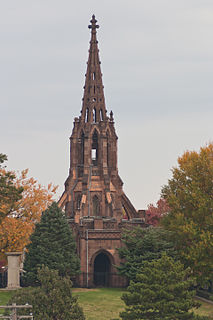
John Rudolph Niernsee was an American architect. He served as the head architect for the Baltimore and Ohio Railroad. Rudolph also largely contributed to the design and construction of the South Carolina State House located in Columbia, South Carolina. Along with his partner, James Crawford Neilson, Rudolph established the standard for professional design and construction of public works projects within Baltimore and across different states in the United States.

Brunswick is a passenger rail station on the MARC Brunswick Line between Washington, D.C. and Martinsburg, West Virginia. The station house, located at 100 South Maple Street in Brunswick, Maryland, is a former Baltimore and Ohio Railroad depot that is a contributing property to the Brunswick Historic District, which has been listed on the National Register of Historic Places since August 29, 1979. The station was designed by Ephraim Francis Baldwin and opened in 1891 on Seventh Avenue. Several years later the building was moved to its current location. It is a wooden frame building with stone walls up to the window sills, and features Palladian windows in the roof dormers.
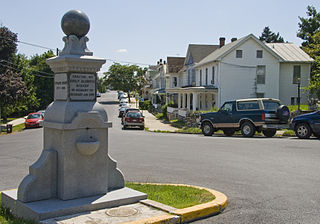
The Boomtown Historic District comprises the western and southern portions of Martinsburg, West Virginia, generally along the alignments of West King Street and Winchester Avenue, following the general path of the town's electric streetcar system. It includes a former industrial section of the town, home to a number of textile mills, as well as the housing that was built for mill workers.

The Boydville Historic District includes an area of Martinsburg, West Virginia that was developed for the well-to-do of Martinsburg at the turn of the twentieth century. The district is named for Boydville, the mansion at the core of the district. The district runs generally along South Queen Street to the south of the Downtown Martinsburg Historic District and to the east of the Boomtown Historic District.
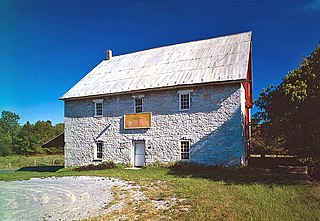
The Bunker Hill Historic District is the center of the town of Bunker Hill, West Virginia. Today located on the road called US 11, the town was developed along the Martinsburg, West Virginia - Winchester, Virginia road. Bunker Hill served southern Berkeley County with three stores, six mills, and five churches. It was also home to a significant African-American population.

The Hinton Historic District is a national historic district located at Hinton, Summers County, West Virginia. The original Hinton Historic District is bordered roughly by the Chesapeake and Ohio Railroad line, James Street, 5th Avenue, and Roundhouse. The boundary increase extended the district to include Mill Street. It was listed on the National Register of Historic Places in 1984 and revised in 2005.

Adam Stephen House is a historic home located at Martinsburg, Berkeley County, West Virginia. It was built between 1772 and 1789, and is a 2+1⁄2-story, stone house measuring 43 feet, 5 inches, by 36 feet, 3 inches. It was the home of Adam Stephen. Built of shaped limestone, it stands on a prominent stone ledge, with two outbuildings in stone and log. After falling into near-ruin, iIt was restored in the 1960s by the General Adam Stephen Memorial Association and is open as a historic house museum. The house was built over a natural cave, with stone steps leading down from the basement. A local caver's organization has worked since 2002 to excavate the cave, which had become plugged with earth, and the excavation is available for tours on open house days.

Tuscarora Creek Historic District is a national historic district located near Martinsburg and Nollville, Berkeley County, West Virginia. It encompasses 31 contributing buildings and three contributing sites, related to the early settlement and economic development along the Tuscarora Creek. Notable buildings in the district include: Patterson's Mill (1765) and the miller's house, "Elm Dale," the Silber-Walters House, Huxley Hall, site of Patterson's New Mill and miller's house, Hibbard Mill, Tuscarora School, Providence Cemetery, the Mong House, Tuscarora Church (1802), James Noll Shop, Rumsey Mill site, and the poor house or "Mansion House" (1788).

Tabler's Station Historic District is a national historic district located near Martinsburg, Berkeley County, West Virginia. It encompasses 19 contributing buildings constructed between about 1890 and 1953. It is primarily residential, but also includes the Tabler Presbyterian Church and Shiftman Brothers Mattress Factory. The houses are of wood-frame construction, between one and 1+1⁄2 stories in height, and are primarily vernacular in character.

Spring Mills Historic District is a national historic district located near Martinsburg, Berkeley County, West Virginia. It encompasses five contributing buildings, constructed between about 1790 and 1922, and two contributing sites. They include the Falling Waters Presbyterian Church (1834) and Manse (1922) and Stephen Hammond Mill, Miller's House, and Spring House. The buildings are of masonry construction. The sites are the Falling Waters Presbyterian Church Cemetery and the site of Dr. Allen Hammonds House.

Jones Mill Run Historic District is a national historic district located near Martinsburg, Berkeley County, West Virginia. It encompasses one contributing building, one contributing site, and two contributing structures. They are the Thomas Swearingen House ; site of the mill, including the stone foundation and head and tail races; and the double stone bridge.

Downtown Martinsburg Historic District is a national historic district located at Martinsburg, Berkeley County, West Virginia. It encompasses 281 contributing buildings. It includes government and industrial buildings, several schools, firehouses, and churches, the two main commercial and professional areas along Queen and King Streets, a major hospital, and surrounding residential areas. The buildings reflect a number of popular 19th-century architectural styles including Gothic Revival, Italianate, and Queen Anne.

Swan Pond Manor Historic District is a national historic district located near Martinsburg, Berkeley County, West Virginia, U.S.A. It encompasses 21 contributing buildings, one site, and one structure, over 2,465 acres. The agricultural district boundaries reflect the Swan Pond Manor land of Thomas Fairfax, 6th Lord Fairfax of Cameron, which he set aside in 1747 as a part of his Northern Neck Territory for his personal use. Notable buildings include the Capt. James Mason House, Kroh-Sprinkle House (1819), Jacob A. Small House, Robert Carter Willis House, Dr. Williams House, "Hollidale," and "Wood Haven" (1895), Raleigh Morgan House. Also located in the district is the separately listed Swan Pond.

Wheeling Historic District, also known as the Wheeling Central Business District, is a national historic district located at Wheeling, Ohio County, West Virginia. The district includes 205 contributing buildings in the central business district of Wheeling. It includes the site of the original location of Fort Henry. The buildings are representative of a number of popular architectural styles from the early-19th century through the present including Greek Revival and Late Victorian. The District was listed on the National Register of Historic Places in 1979.

Wheeling Warehouse Historic District is a national historic district located at Wheeling, Ohio County, West Virginia. The district includes 20 contributing buildings and 11 contributing structures. They are warehouses and commercial style buildings and structures between Main Street and the Ohio River. All of the buildings date to the late-19th and early-20th century. The warehouses are mostly two- and three-story masonry buildings. The two-story commercial buildings have storefronts on the first floor and residential units above. Notable buildings and structures include the Pump Store (1933), Wheeling Stamping Plant (1932), Allied Plate Glass, Warwick China, Boury Warehouse, Ott-Heiskell Company, Edward Wagner Wholesale Grocers building (1915), the Moderne style former Greyhound Bus Station, and Main Street Bridge (1891).

West Martinsburg Historic District is a national historic district located at Martinsburg, Berkeley County, West Virginia. It encompasses 138 contributing buildings constructed between about 1900 and 1956. It is primarily residential and many of the earlier houses in the district represent the “small house” movement of the 1920s and 1930s. The houses reflect popular architectural styles from the first half of the 20th century including the Bungalow, American Craftsman, American Foursquare, and Colonial Revival styles.

The Nashua Manufacturing Company Historic District in Nashua, New Hampshire, is a historic district that was listed on the National Register of Historic Places (NRHP) in 1987. It encompasses an area just west of downtown Nashua, roughly located along the southern bank of the Nashua River, bordered on the west side by Mine Falls Park, on the south side by the Nashua River canal, up to Ledge Street, and from the east side by Factory, Pine and Water streets, up to the Main Street bridge.






















